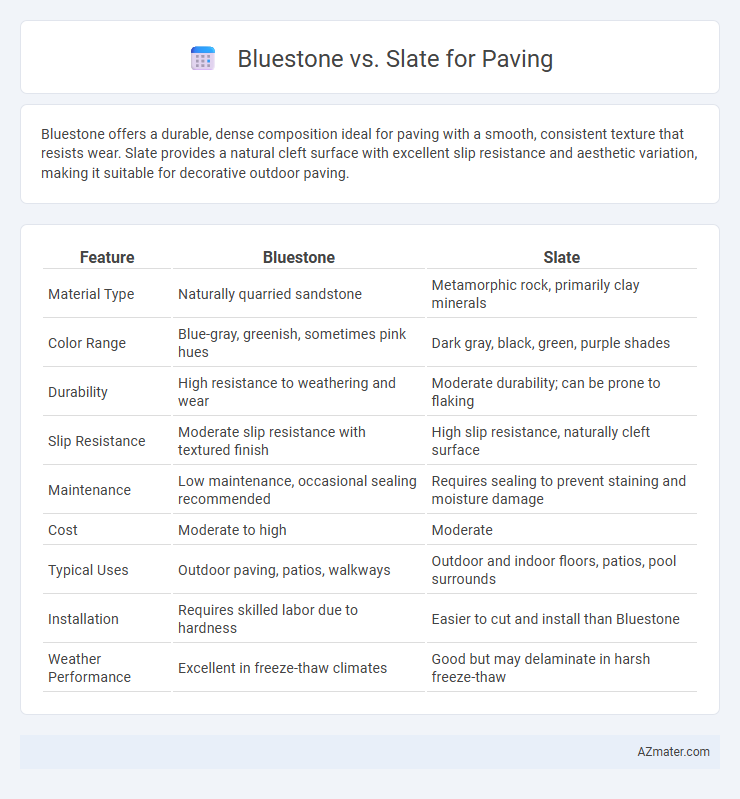Bluestone offers a durable, dense composition ideal for paving with a smooth, consistent texture that resists wear. Slate provides a natural cleft surface with excellent slip resistance and aesthetic variation, making it suitable for decorative outdoor paving.
Table of Comparison
| Feature | Bluestone | Slate |
|---|---|---|
| Material Type | Naturally quarried sandstone | Metamorphic rock, primarily clay minerals |
| Color Range | Blue-gray, greenish, sometimes pink hues | Dark gray, black, green, purple shades |
| Durability | High resistance to weathering and wear | Moderate durability; can be prone to flaking |
| Slip Resistance | Moderate slip resistance with textured finish | High slip resistance, naturally cleft surface |
| Maintenance | Low maintenance, occasional sealing recommended | Requires sealing to prevent staining and moisture damage |
| Cost | Moderate to high | Moderate |
| Typical Uses | Outdoor paving, patios, walkways | Outdoor and indoor floors, patios, pool surrounds |
| Installation | Requires skilled labor due to hardness | Easier to cut and install than Bluestone |
| Weather Performance | Excellent in freeze-thaw climates | Good but may delaminate in harsh freeze-thaw |
Introduction to Bluestone and Slate
Bluestone and slate are popular natural stones used for paving due to their durability and aesthetic appeal. Bluestone is a dense, fine-grained sandstone typically found in the northeastern United States, known for its blue-gray hues and slip-resistant surface. Slate, a metamorphic rock formed from shale, offers a smooth texture with a variety of colors ranging from dark gray to green and is prized for its splitability and weather resistance.
Material Composition and Origins
Bluestone, primarily composed of feldspathic sandstone rich in quartz and feldspar, originates mainly from regions like Pennsylvania and New York, offering a dense and durable surface ideal for paving. Slate consists of fine-grained metamorphic rock formed from shale or mudstone, predominantly found in areas such as Vermont and Wales, characterized by its natural cleft and smooth texture. The distinct mineral compositions and geological formations of Bluestone and Slate influence their durability, slip resistance, and aesthetic appeal in paving applications.
Aesthetic Appeal: Color and Texture
Bluestone offers a refined, uniform blue-gray hue with subtle variations that create a sleek, modern look, while slate provides a broader color palette ranging from deep blacks and greens to purples and rusts, delivering a more rustic and natural aesthetic. The smooth, dense texture of bluestone complements contemporary designs, whereas slate's naturally cleft surface adds rich, tactile elements ideal for traditional or eclectic paving projects. Both materials enhance outdoor spaces but differ significantly in visual impact through their distinctive color depth and surface character.
Durability and Longevity Comparison
Bluestone exhibits exceptional durability with high resistance to chipping and cracking, making it ideal for high-traffic paving areas. Slate, while aesthetically appealing due to its fine-grained texture, tends to be more prone to splitting and weather-related wear over time. Bluestone's dense composition ensures superior longevity, often lasting several decades without significant deterioration compared to slate's moderate lifespan under similar conditions.
Slip Resistance and Surface Safety
Bluestone offers a naturally textured surface with high slip resistance, making it ideal for safe, non-slip paving in wet or icy conditions. Slate's smooth, dense structure can become slippery when wet, requiring additional treatments or finishes to enhance surface safety. Choosing bluestone ensures better traction and reduces the risk of slips and falls in outdoor paving applications.
Maintenance and Cleaning Requirements
Bluestone requires regular sealing to prevent staining and maintain its color, with routine sweeping and occasional pressure washing recommended for upkeep. Slate is naturally more resistant to staining and weathering, needing less frequent sealing but still benefits from gentle washing and prompt removal of dirt and debris. Both materials demand attention to grout or joint areas to avoid moss and weed buildup, ensuring long-lasting paving durability and aesthetics.
Installation Process and Costs
Bluestone offers a smoother installation process due to its consistent thickness and ease of cutting, reducing labor time compared to slate, which often requires additional shaping because of its uneven surface. Slate's variable thickness and natural cleft textures can increase installation complexity and associated costs, demanding more skilled labor to ensure a level surface. Cost-wise, bluestone tends to be more affordable both in material price and installation expenses, while slate, being a premium material, results in higher overall project costs driven by its intricate handling requirements.
Climate Suitability and Weather Resistance
Bluestone offers excellent climate suitability due to its dense composition, making it highly resistant to extreme weather conditions such as heavy rain, snow, and freeze-thaw cycles. Slate, while durable, is more susceptible to chipping and erosion when exposed to harsh weather variations over time. For regions with fluctuating temperatures and heavy precipitation, bluestone provides superior weather resistance and long-lasting paving performance.
Eco-Friendliness and Sustainability
Bluestone is typically quarried with less environmental disruption and requires minimal processing, making it an eco-friendly choice for paving. Slate, while durable, often involves energy-intensive extraction and finishing techniques, which can increase its environmental footprint. Both materials offer longevity that reduces the need for frequent replacements, but Bluestone's natural availability and lower carbon extraction process contribute more favorably to overall sustainability in paving applications.
Final Verdict: Choosing the Best Stone for Your Paving
Bluestone offers superior durability and a smooth, non-slip surface ideal for high-traffic paving areas, making it a popular choice for both residential and commercial projects. Slate provides a unique, natural texture with rich color variations that add aesthetic appeal but may require more maintenance due to its susceptibility to chipping and weathering. For long-lasting, low-maintenance paving, bluestone is the best option, while slate is preferable for decorative applications where visual impact is the priority.

Infographic: Bluestone vs Slate for Paving
 azmater.com
azmater.com